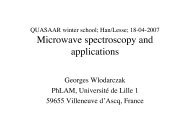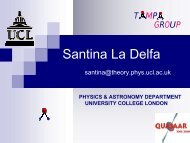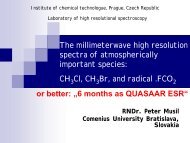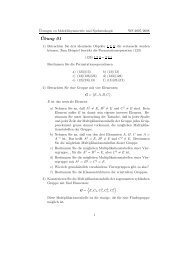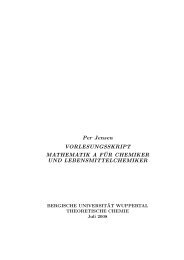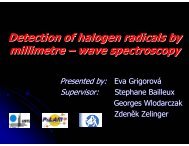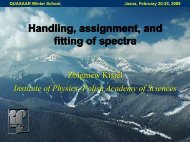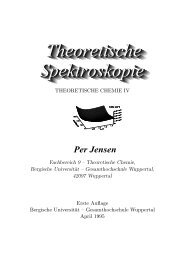- Page 1 and 2:
Book of abstractsof the 22 th Inter
- Page 3 and 4:
CommitteesLocal Organizing committe
- Page 5:
Table of contentProgram of sessions
- Page 8 and 9:
8 Program of sessionsInvited Lectur
- Page 10 and 11:
10 Program of sessionsD6 Tasinato N
- Page 12 and 13:
12 Program of sessionsD23 Underwood
- Page 14 and 15:
14 Program of sessionsD43 Kirkpatri
- Page 16:
16 Program of sessionsG5 Ebert V. 1
- Page 20 and 21:
20 Program of sessionsH36 Vogt N.,
- Page 22 and 23:
22 Program of sessionsJ8 Tudorie M.
- Page 24 and 25:
24 Program of sessionsJ26 Osman O.,
- Page 26 and 27:
26 Program of sessionsIoannes Marcu
- Page 28 and 29:
28 Program of sessionsContributed L
- Page 31 and 32:
Invited LecturesASeptember 4, Tuesd
- Page 33:
Invited Lectures, A2 33Ultra sensit
- Page 36 and 37:
36 Contributed Lectures, B1Chirped-
- Page 38 and 39:
38 Contributed Lectures, B3Chirped
- Page 40 and 41:
40 Contributed Lectures, B5Laborato
- Page 43 and 44:
Invited LecturesCSeptember 4, Tuesd
- Page 45:
Invited Lectures, C2 45Chiral recog
- Page 48 and 49:
48 Poster session, D1Spectroscopic
- Page 50 and 51:
50 Poster session, D3Ab-initio norm
- Page 52 and 53:
52 Poster session, D5The 2 and 4
- Page 54 and 55:
54 Poster session, D7IR spectroscop
- Page 56 and 57:
56 Poster session, D9The stretching
- Page 58 and 59:
58 Poster session, D11Rotationally-
- Page 60 and 61:
60 Poster session, D13Frequency ana
- Page 62 and 63:
62 Poster session, D15High-L atomic
- Page 64 and 65:
64 Poster session, D17High-Resoluti
- Page 66 and 67:
66 Poster session, D19Frequency-com
- Page 68 and 69:
68 Poster session, D21Variational c
- Page 70 and 71:
70 Poster session, D23Variationally
- Page 72 and 73:
72 Poster session, D25MOGADOC - A D
- Page 74 and 75:
74 Poster session, D27Theoretical I
- Page 76 and 77:
76 Poster session, D29Spectroscopy
- Page 78 and 79:
78 Poster session, D31Coriolis Anal
- Page 80 and 81:
80 Poster session, D33Symmetric gro
- Page 82 and 83:
82 Poster session, D35Dissociative
- Page 84 and 85:
84 Poster session, D37Absorption sp
- Page 86 and 87:
86 Poster session, D39Low-energy vi
- Page 88 and 89:
88 Poster session, D41New progress
- Page 90 and 91:
90 Poster session, D43High Resoluti
- Page 93 and 94:
Invited LecturesESeptember 5, Wedne
- Page 95:
Invited Lectures, E2 95Theoretical
- Page 98 and 99:
98 Contributed Lectures, F1On the r
- Page 100 and 101:
100 Contributed Lectures, F3High Re
- Page 102 and 103:
102 Contributed Lectures, F5Large A
- Page 105 and 106:
Contributed LecturesGSeptember 5, W
- Page 107 and 108:
Contributed Lectures, G2 107Inversi
- Page 109 and 110:
Contributed Lectures, G4 109Spontan
- Page 111:
Contributed Lectures, G6 111High te
- Page 114 and 115:
114 Poster session, H1Computation o
- Page 116 and 117:
116 Poster session, H3Rotationally-
- Page 118 and 119:
118 Poster session, H5The Rotationa
- Page 120 and 121:
120 Poster session, H7Laser-Induced
- Page 122 and 123:
122 Poster session, H9High resoluti
- Page 124 and 125:
124 Poster session, H11Structure, U
- Page 126 and 127:
126 Poster session, H13From succini
- Page 128 and 129:
128 Poster session, H15On the “Ex
- Page 130 and 131:
130 Poster session, H17Hyperfine sp
- Page 132 and 133:
132 Poster session, H19The first ro
- Page 134 and 135:
134 Poster session, H21High Resolut
- Page 136 and 137:
136 Poster session, H23Spectroscopy
- Page 138 and 139:
138 Poster session, H25New investig
- Page 140 and 141:
140 Poster session, H27Submillimetr
- Page 142 and 143:
142 Poster session, H29First analys
- Page 144 and 145:
144 Poster session, H31High-Resolut
- Page 146 and 147:
146 Poster session, H33Rotational s
- Page 148 and 149:
148 Poster session, H35New assignme
- Page 150 and 151:
150 Poster session, H37Hydrogen Sul
- Page 152 and 153:
152 Poster session, H39New Millimet
- Page 154 and 155:
154 Poster session, H41First analys
- Page 156 and 157:
156 Poster session, H43High-Resolut
- Page 159 and 160:
Invited LecturesISeptember 6, Thurs
- Page 161:
Invited Lectures, I2 161New Telesco
- Page 164 and 165:
164 Poster session, J1Synthesis, Ch
- Page 166 and 167:
166 Poster session, J3Radio Search
- Page 168 and 169:
168 Poster session, J5N 2 -, O 2 -
- Page 170 and 171:
170 Poster session, J7Quantum-class
- Page 172 and 173:
172 Poster session, J9On the ECS fo
- Page 174 and 175: 174 Poster session, J11Measurement
- Page 176 and 177: 176 Poster session, J13Review of th
- Page 178 and 179: 178 Poster session, J15Halogen bond
- Page 180 and 181: 180 Poster session, J17Multispectru
- Page 182 and 183: 182 Poster session, J19Potential en
- Page 184 and 185: 184 Poster session, J21The Study of
- Page 186 and 187: 186 Poster session, J23Pollutants m
- Page 188 and 189: 188 Poster session, J25Preparation
- Page 190 and 191: 190 Poster session, J27Databases of
- Page 192 and 193: 192 Poster session, J29Ozone FTS sp
- Page 194 and 195: 194 Poster session, J31Joint Ro-Vib
- Page 196 and 197: 196 Poster session, J33Water vapor
- Page 198 and 199: 198 Poster session, J35Line positio
- Page 200 and 201: 200 Poster session, J37Hyperfine St
- Page 202 and 203: 202 Poster session, J39Rotational a
- Page 204 and 205: 204 Poster session, J41Tissue Bondi
- Page 207 and 208: Ioannes Marcus MarciKSeptember 6, T
- Page 209 and 210: Invited LecturesLSeptember 7, Frida
- Page 211: Invited Lectures, L2 211Collision-I
- Page 214 and 215: 214 Contributed Lectures, M1Flexibl
- Page 216 and 217: 216 Contributed Lectures, M3Continu
- Page 218 and 219: 218 Contributed Lectures, M5High-pr
- Page 221 and 222: Contributed LecturesNSeptember 8, S
- Page 223: Contributed Lectures, N2 223Two- di
- Page 227 and 228: Contributed Lectures, N6 227Spin-or
- Page 229 and 230: Contributed Lectures, N8 229Quantum
- Page 231: Contributed Lectures, N10 231Line m
- Page 234 and 235: 234 Author indexAAbdelghany A. —
- Page 236 and 237: 236 Author indexChoi B. — D33Ciur
- Page 238 and 239: 238 Author indexGGambi A. — D6Gä
- Page 240 and 241: 240 Author indexKhelkhal M. — D29
- Page 242 and 243: 242 Author indexMartin M.A. — D31
- Page 244 and 245: 244 Author indexPolyansky O. — D2
- Page 246 and 247: 246 Author indexSzajna W. — H29,
- Page 248 and 249: 248 Author indexZamotaeva V.A. —
- Page 250 and 251: 250 EmailsAbdelghany A.Abdelghany A
- Page 252 and 253: 252 EmailsGuarnieri A.ag@tf.uni-kie
- Page 254 and 255: 254 EmailsMichaut X.Xavier.Michaut@
- Page 256 and 257: 256 EmailsTyuterev Vl.G.vladimir.ti
- Page 258 and 259: FT-IR spectrometerIFS 125HROutstand
- Page 260 and 261: 32nd International Symposium on Fre
- Page 262 and 263: Some more information
- Page 264: Addresses:Conference Site: National




